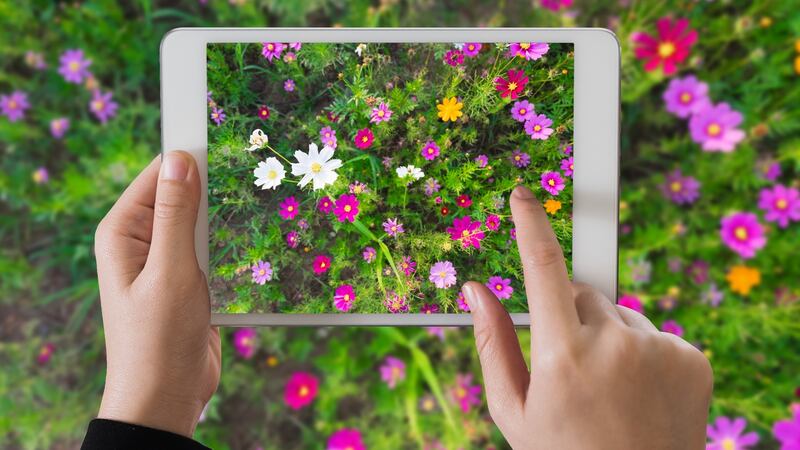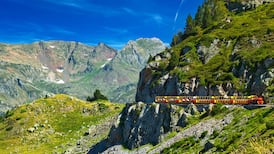The opening to the sun of a new wildflower species almost every day, the arrival from distant lands of swallows, martins, terns and warblers, all in beautiful spring weather – this annual Sursum Corda in nature’s liturgy has taken on an especially poignant significance this year, even for those who have not paid much attention to such things previously.
But they also spark our own instincts for migration, whether that be to a beach outside our 2km limit to see if the terns can now be heard, crying insistently above the sound of the waves, or to visit biodiverse landscapes abroad that now seem as remote as Mars.
There are at least two ways to appease this hunger, within our current confinement. One is to make the micro macro, as it were, and take the time to pay attention to the small miracles of evolution still surrounding you: the lichens on our windowsills, perhaps, or the composite structure of a daisy flower head on our lawns, seen through a magnifying lens.

But we can also use our online devices as windows to the broader worlds from which we find ourselves excluded. This is a good time to explore the first drafts of new work by great nature writers on their blogs and social media pages, and to swim luxuriously in luminous plant, wildlife and landscape images by photographers.
Any selection from the galaxies of such material online is bound to be idiosyncratic. To make your own choices, just Google “best nature blogs” and you will find enough options for a year in isolation, just on the first page.
But it may be helpful to scan these tasting notes on a few blogs and social media feeds that I have found to be sources of uplifting and insightful writing, and of images to delight the eye, from at home and abroad.
It’s true that many bloggers have moved to media such as Facebook and Instagram in recent times, reflecting the chronic shortening of our attention spans. But the current period of stasis in our lives offers a golden opportunity to immerse ourselves in blogs where longer form writing and copious illustration is an art form.
Ramble
Few nature writers in recent years can match David George Haskell for very close observation of nature, lucid communication of science, and poetic vision. His books include The Forest Unseen, nominated for a Pulitzer Prize, where he demonstrated that a single square metre of old-growth woodland floor in Tennessee could provide entertaining and revealing material for a year’s intense scrutiny. So he’s probably doing better than most of us in isolation.
His blog is called simply Ramble. Recent posts include summaries of, and links to, his myriad, illuminating and provocative thoughts on birdsong in longer articles. The music of birds, he points out, is created by a “unique and marvellous sound-making organ, only the size of a lentil or a bean. Into this tiny space are interwoven a dozen rings of bone and two dozen muscles, all connected to lips and membranes of soft flesh. The muscles are among the fastest known . . . contracting up to 200 times a second.”
Birds, he continues, “are quick-fingered jewellers of air, crafting dozens of ornamented gems every second”. That’s before he begins to explain the divergent evolution, over 300 million years, between the avian and human sonic worlds.
Yet despite this distance, he argues that we "should not allow otherness to bar the door to kinship, curiosity and imagination. There is a bridge. That bridge is the gift of our attention". Exquisite illustrations and audio files complement this richly rewarding piece.
https://dghaskell.com/ramble-posts/
10 Things Wrong with Environmental Thinking
A very different but equally entertaining and thought-provoking online cornucopia is offered by the Chicago-based Irish ecologist Liam Heneghan. He is the author of Beasts at Bedtime: Revealing the Environmental Wisdom of Children’s Literature, and is an occasional contributor to the books pages of this newspaper.
He is unusual in bringing rigorous philosophical enquiry to ecological issues but, never fear, he wears it all lightly. His blog, 10 Things Wrong with Environmental Thinking, is witty, literate and highly eclectic, and challenges comfortable clichés we use about the natural world. Here is a flavour of his core theme:
"Environmental thought has suffered from confusions about definitions of nature, confusion about the dynamics of nature, confusion about our place in nature, some suspicious hankerings after purity, after perfect origins, and it revels in drastic and usually self-defeating predictions about end times." He is a good antidote, then, to apocalyptic fantasies about Covid-19. Other topics range from the Hindu Upanishads to invasive species, and from unpublishable poems to Midnight Mass in 1970s Dublin.
http://10thingswrongwithenvironmentalthought.blogspot.com/
The Hollywood Forest Story
Cathy Fitzgerald, whom we interviewed recently on these pages, describes herself as an “eco-social art practitioner” and educationalist, and her blogs and other social media posts reflect this range of interests. Her major project, with her husband the sculptor Martin Lyttle, is the transformation of a monocultural pine plantation in Carlow into “a flourishing and permanent, mixed-species forest”.
The Hollywood Forest Story itself has an online life like a rapidly growing tree, branching out in many directions and multiple media, and interchanging nutrition and energies with other sources of knowledge. It opens up many pathways, so be prepared to enjoy getting productively lost for hours. https://hollywoodforest.com/blog/
Young Fermanagh Naturalist
If you can be an international legend at 16, Dara McAnulty has achieved that status through his remarkable blog about the impact of enjoying the natural world on a youth marked by Asperger's syndrome. He has not blogged much lately, probably because he has just published his first book, Diary of a Young Naturalist, details of which are on Twitter. But it's still well worth catching up on his previous blog posts at https://youngfermanaghnaturalist.wordpress.com/
Julian Hoffman
Finally, if you want to travel the world in the company of a magical writer who passionately engages with special places – and the people who cherish them – Julian Hoffman, author of The Heart of Small Things and Irreplacable, is an incomparable companion.
He is now unable to travel into his beloved Prespa lakes basin, just over the hills from his home in Greece. So in his latest post he promises us this: “Over the coming days and weeks I’ll reacquaint myself with our home region through memory, sharing photos of these landscapes and their wild citizens from earlier walks and wanders, as well as some of their stories, too.”
And while many of the places he visits are far off from us, he constantly reminds us, quoting Alix Kates, that “within walking distance of any spot on Earth there’s probably more than enough mystery to investigate in a lifetime”.
Perhaps that's a cue to start your own blog, right now, right where you are.
https://julian-hoffman.com/
Some other online sources
Delightful notes from Liam Lysaght:
https://wildirelandtour.ie/
Test your bird identification, plus many more options, with Birdwatch Ireland:
https://www.facebook.com/BirdWatchIreland/
Ireland's public awareness campaign on biodiversity:
http://www.noticenature.ie/
The National Biodiversity Centre blog
https://www.biodiversityireland.ie/category/blog/
Butterfly Conservation Ireland on what's in flight right now
https://www.facebook.com/ButterflyConservationIreland/
Zoë Devlin charts emerging wildflowers
http://www.wildflowersofireland.net/index.php
The Wicklow Wildlife Group
https://www.facebook.com/groups/337417226756587/
Irish Birding updates on sightings and photos, though it's a vicarious pleasure at present
http://www.irishbirding.com/birds/web
Two international image-based sites to knock your socks off:
https://thesmallermajority.com/











